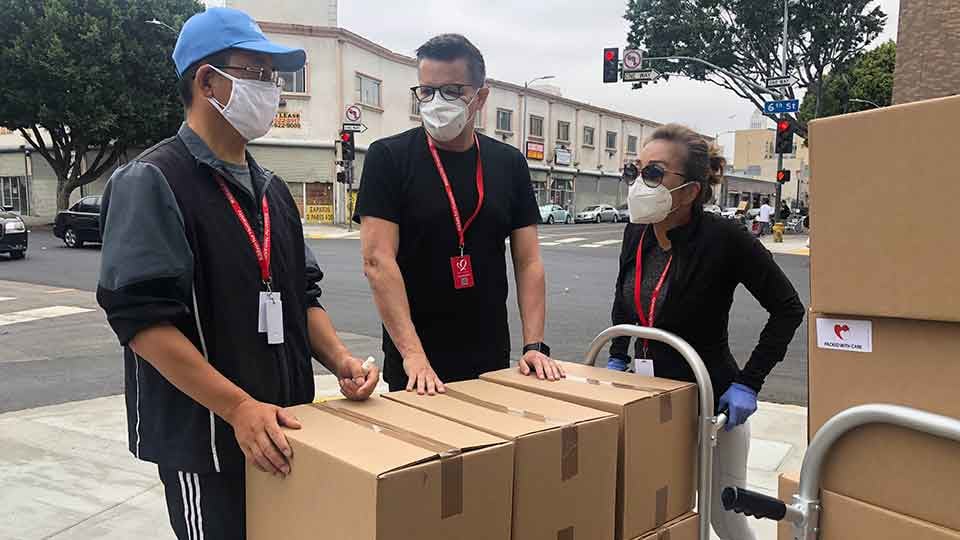You’ve heard the horror stories: a friend of a friend’s cousin ships a valuable item cross country. The package gets lost for weeks, your friend’s friend’s cousin finally gives up on ever seeing their valuables again, and finally they receive a box of broken pieces.
While this is an example of how cargo damage could happen in your individual life, the same happens to businesses when they ship less-than-truckload freight.
How common is this scenario really? How does freight get damaged during transit? And what can you do to keep your items intact during shipping and handling?
It can be nerve-wracking to send valuable goods to faraway destinations. At Anderson Trucking Service (ATS), we work with customers every day to safely transport all kinds of cargo across the state and around the world. In fact, our founder was an early innovator in combining products from several shippers onto one truck, a precursor to today’s LTL freight industry.
Unless you are moving tens of thousands of pounds at once, you are most likely shipping less than a full truckload. Less-than-truckload (LTL) shipping happens every day, usually without incident). Read on to learn more about how these shipments work, how they compare to the alternatives and how to protect your goods.
What Is Less Than Truckload (LTL) Freight?
Less Than Truckload (LTL) freight is exactly what it sounds like — any freight that does not fill the entire truck. LTL shipments usually fill only a small portion of the truck, like a handful of pallets or crates. Shipments that fill most of the truck are often considered partial truckload, or PTL; full truckload or FTL shipments fill the entire truck. (Yes, the trucking industry loves acronyms).
Any size truck and trailer can be used for LTL freight. These shipments are less expensive to send than PTL or FTL shipments because you are splitting the cost of the truck and driver among multiple shippers. Sending an LTL shipment is often the cheapest way to get your freight from your location to your customer without making any more arrangements.

Is LTL Freight More at Risk for Damage?
With FTL service, freight is loaded at the point of origin and unloaded at the destination. Securements are attached at the shipper, the trailer is sealed and your freight is untouched until the truck is unloaded.
LTL freight has a more complicated journey. It is not cost effective to transport a partially empty truckload, so the driver will make several stops along the route to load and unload cargo from other shippers and deliver freight to different locations.
Other items will be loaded, unloaded and moving around the trailer and into various locations, including warehouses. You do not have control over what else is in the truck. While everyone responsible is handling every item with care, more touches means more opportunities for freight damage.
Most LTL shipments arrive at their final destination without any damage. But with the sheer volume of freight moving around via dedicated carriers and commercial carriers like FedEx or UPS, it is likely that your friend’s friend’s cousin will have a horror story. You can protect your freight with insurance and by carefully preparing your shipment.
Is LTL Freight Covered by Cargo Insurance?
A critical difference between LTL and FTL freight is that FTL freight is covered by cargo liability insurance. With LTL freight, insurance is an optional addition. Before booking, make sure you understand if insurance is included in your quote, and the amount of coverage you can receive.
Because LTL shipments are not always insured, damage may be more painful than damage to an FTL shipment. Without insurance, you will likely end up financially responsible for LTL freight damage.
Fortunately, cargo insurance is available. When booking, ask your representative to include cargo insurance in your quote. You could also source and acquire insurance for your LTL freight shipment, but this is a less convenient option.
How to Prevent LTL Freight Damage
While you can’t control what happens during transit, you can take a few simple steps to protect your assets. Whether you have just a few items in the truck or it is nearly full with your freight, packing carefully matters. Here are four tips to keep your cargo safe during LTL shipments.
Crate Your Freight
The most secure way to pack freight for an LTL shipment is in a shipping crate. A crate will protect your cargo from damage from forklifts and heavy equipment, the impact of other freight and jostling or sliding within the vehicle.
Crates can be made of wood, plastic or other sturdy materials. If you use a crate for your shipment, be sure to include the weight of the packed crate and packing material in your initial specification, as well as the length, width and height.
Use an Oversize Pallet
Wooden pallets are one of the most common ways to load and pack freight in a trailer. Pallets make it easier to load and unload the truck using a forklift or pallet jack. They also protect your freight.
Picture a box sitting on the floor of a truck. If it’s the only thing inside the truck, it will likely slide around without causing or sustaining any damage. However, larger items inside the truck may collide with or fall on your box, causing it to be crumpled or crushed.
Placing the box on a pallet will mean nothing comes in contact with the box. For ultimate protection during the move, use a pallet that is larger than the item being shipped. This will protect the sides and corners of your shipment from the impact of other objects.

Be Precise in Your Spec
When you contact your LTL carrier, be prepared to specify the exact length, width, height and weight of your load (including its container), as well as the type of freight. The representative will help you classify your freight based on type of material and density.
This information will help the driver prepare with the correct safety materials, saving you time and money during your shipment while protecting it. Incorrect weight or dimensions will cause the carrier to lose business opportunities, and they will add LTL surcharges greater than the cost of specifying the correct, higher weight the first time.
Specify Your Conditions
If you do not have a loading dock available at your origin or destination points, if the freight must be picked up or dropped off at a residential address or you require other special handling, specify that as soon as possible when booking your LTL shipment. This will help your freight load and unload safely, and it can help you avoid surcharges often imposed when the driver has to do additional tasks not originally specified.
There’s no way you can completely guarantee your LTL freight shipment will arrive intact, but taking these simple steps can keep your freight secure.
How to Ship LTL Freight
There are some steps that may not directly relate to the safety of your freight, but it will help your driver ensure a smooth, easy drive. This can also help keep your shipment on track and reduce stress for the driver, often leading to a decrease in add-on charges. Taking common sense precautions like setting up business hours, labeling, using a terminal and questioning guarantees are one way to help your freight arrive intact.
Know the Business Hours at Both Ends
Before contacting the carrier, know the business hours and limitations at the points of origin and destination. Provide this information with the initial specification so they can stipulate the hours in your quote and on your bill of lading (BOL).
If you are shipping to or from a residence, specify this at the time of quote. Residential deliveries require an appointment, and most residential streets are not designed to handle the weight of a loaded truck. Drivers and carriers must make special arrangements for residential deliveries, and making these arrangements before the shipment is picked up will save significant money and time.
Label Clearly
Most LTL carriers and logistics companies will provide blank copies of shipping labels and bills of lading with the cargo’s value clearly stated. Securely attach these to the shipping container and make sure they are visible. Having your containers labeled and accessible when the driver arrives will ease the pickup process and help direct your freight to the proper destination.
Shorten the Trip by Using a Terminal
In most cases, you can arrange to pick up your LTL shipment at a local terminal. This eliminates one step of the handling process, and it means you no longer have to worry about hours of service at your destination point. If you have the ability to pick up or drop off the freight yourself, this can save valuable time. If you plan to use a terminal, that information needs to be in the initial specification.
Be Skeptical About Guarantees
LTL shipments should take one day to pick up and travel to the first terminal, one day to travel from the end terminal to the final dropoff point, as well as one more (or more) travel day(s) between terminals. (At the maximum, a driver can travel about 500 miles a day. For LTL shipments that involve multiple stops and driving on lower-speed roads, expect less than that).
If your provider is guaranteeing delivery in two days, be sure to clarify if that means two days until the load is in hand. Also clarify what happens if no one is available to receive the shipment — will the driver leave it outside the door, or will they return another day?
If you do require a two-day shipping guarantee, consider LTL expedited services. Expedited service must be specifically requested and works fast. Expedited service is more expensive than traditional LTL delivery, and quotes must be accepted quickly.
How to Submit an LTL Freight Claim
The claim submission process is identical for LTL and FTL freight. Your role is to place a claim with the carrier and provide thorough documentation to back up your claim. The sooner you can do this after receiving the damaged freight, the better.
- If you notice the damage right away, accept the shipment as Damaged Pending Claim. The consignee must note this on the BOL, and must sign after notation. Ask the driver to sign also, and get a copy of the BOL.
- If you notice the damage as you unpack your freight from the shipping container, fully unpack the container, evaluate the damage and take as many photos as possible.
- Contact the carrier with your photos and information, including the value of the damaged items. From this point, you will work with the carrier to file a claim.
The Carmack Amendment specifies that the carrier is responsible for damage to freight. According to the terms of the amendment, you have nine months to file a claim. The type of insurance coverage your carrier holds as well as the classification of your freight (and how well you have documented your freight classification) will determine how much you are reimbursed.
Note: If you worked with a third-party logistics (3PL) provider for your shipment, they may be able to help you with your claim. Whether you worked directly with the carrier or with a 3PL, contact the representative who helped you book the load for assistance as soon as possible.
How to Safely Ship LTL Freight
While you may have heard horror stories of shipments gone wrong, the vast majority arrive safely at their final destination. Instead of worrying about results like your friend’s friend’s cousin, you can use information about specifying and packing LTL freight to ensure a safe shipment. No matter the size of your shipment, you deserve the best care and service every step of the way.
If you aren’t quite sure if LTL shipping is for you, learn more about the process to help ease your mind.





